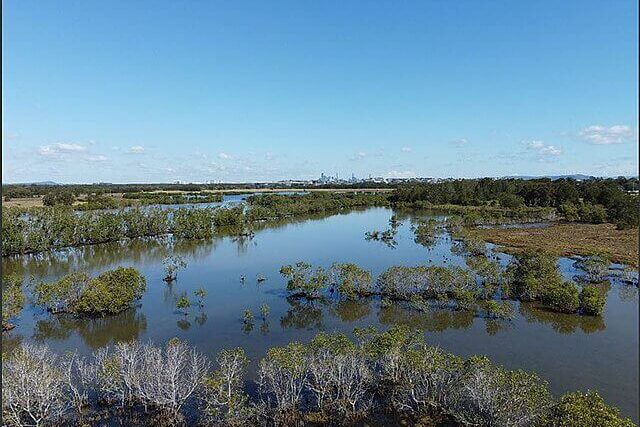
Researchers estimate that half of Europe’s wetlands have been lost over the past 300 years.
In the last 300 years, half of the wetlands in Europe, the continental United States, and China have been destroyed, with some areas, like the UK, Ireland, and Germany, losing more than 75%, according to new research. An area the size of India has vanished worldwide.
Prior estimates suggested that between 28% and 87% of wetlands had been destroyed since 1700, but the exact number of remaining wetlands was unknown up until this point. To get a better picture of the world, researchers combined global historical records with maps of today’s wetlands for the first time. They found that an estimated 20% of all wetlands had been destroyed. However, Europe suffered the most, with Ireland losing more than 90% of its wetlands, Germany, Lithuania, and Hungary losing more than 80%, and Italy, the UK, and the Netherlands losing more than 75%.
Despite some regions being very badly affected, the overall picture shows there is a lot left to save, say the researchers. “This is good news – it’s actually not too late to protect the majority of the wetlands in the world,” said lead author Etienne Fluet-Chouinard, from Stanford University.
Farmers have drained wetlands because they saw them as unproductive land for thousands of years. However, the rate of destruction has accelerated rapidly over the past century. According to the research that was published in Nature, this, in addition to the effects of the climate crisis, groundwater extraction, fires, and rising sea levels, has made wetlands one of the most endangered ecosystems in the world.
Scientists tended to focus on areas where the loss was greatest (often those where the majority of people live) and then extrapolate those numbers, which probably led to inaccurate estimates in the past. However, a sizable portion of the planet’s peat bogs, mires, and floodplains are still present in sparsely populated regions like the Amazon, northern Canada, Siberia, and the Congo. Alaska also has a lot of wetlands, bringing the average loss in the United States down to about 40%.
According to the paper, drainage for growing crops on uplands caused more than 60% of losses worldwide, followed by conversion for paddy fields (18%) and the creation of urban areas (8%). Peat extraction resulted in a loss of less than 1%. Peatlands are essential ecosystems to preserve if climate goals are to be met because they store twice as much carbon globally as forests.
Wetland biodiversity is critical: They are the breeding grounds for up to 40% of the world’s species. They also improve the physical well-being of people living in urban areas, protect against flooding, and purify the water.
When farmers received government subsidies to drain land in North America, Europe, and China in order to create fertile land for agriculture and forestry, the destruction occurred at its quickest in the 1950s. Spain is the only country in Europe that has preserved more than half of its wetlands.
Fluet-Chouinard said: “Now that we know the extent that’s been lost – and the benefits that are lost with the wetlands – we can make more educated and informed decisions about how we want to manage our landscapes.”
The research team first looked at maps of wetlands, which are now mostly made with satellite imagery. Next, they looked at digitised older records, many of which date back to the 1900s. They looked at over 3,000 land use and drainage records all together. The researchers assert that wetlands have been lost by as much as 35% due to inconsistent data on the amount of land drained prior to 1850.
It’s important to figure out the exact number because it can help direct conservation efforts. Campaigners are encouraged by the fact that the Convention on Biological Diversity agreement, which was signed at Cop15 in December, stipulated that 30% of land, sea, and inland water must be protected. This gives them hope that freshwater ecosystems will no longer be overlooked.
“The amount of wetland loss they’ve reported may be less than previously feared, though it is no less worrying,” said Dr Christian Dunn, from Bangor University and chair of the British Ecological Society Welsh Policy Group, who was not involved in the research. “It’s essential that we stop looking at wetlands as wastelands, there for us to drain and repurpose into ‘useful’ land.
“Wetlands are actually the superheroes of the natural world and can provide us with the ultimate nature-based solutions to tackle climate breakdown and its effects. We must do everything we can to not just halt this 20% loss but actually reverse it, and increase our wetland areas as a matter of urgency.”
——————————————————————————
At Natural World Fund, we are passionate about stopping the decline in our wildlife.
The declines in our wildlife is shocking and frightening. Without much more support, many of the animals we know and love will continue in their declines towards extinction.
When you help to restore a patch of degraded land through rewilding to forests, meadows, or wetlands, you have a massive impact on the biodiversity at a local level. You give animals a home and food that they otherwise would not have had, and it has a positive snowball effect for the food chain.
We are convinced that this is much better for the UK than growing lots of fast-growing coniferous trees, solely to remove carbon, that don’t actually help our animals to thrive.
This is why we stand for restoring nature in the UK through responsible rewilding. For us, it is the right thing to do. Let’s do what’s right for nature!
Support our work today at https://naturalworldfund.com/ and join in the solution!

